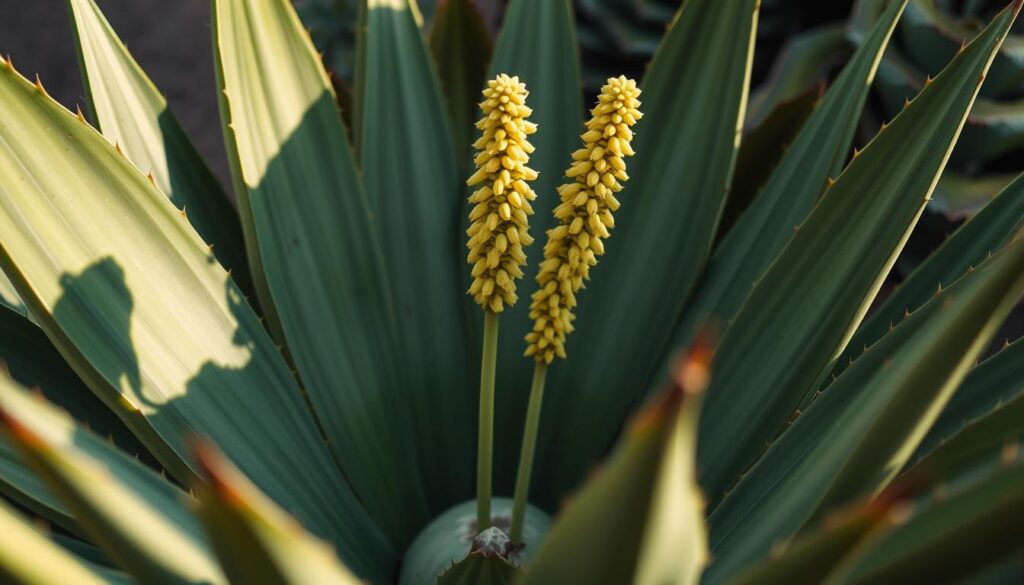I still remember the first time I saw a twin flowered agave. It was in a garden, standing tall with its striking rosette of dark green leaves. The symmetrical foliage caught my eye, and I was amazed by the sharp edges and the flat, gray spine at the tip of each leaf. It looked almost sculptural, like a piece of art placed perfectly in the garden.
What really sets this agave apart is its impressive flower stalk. Rising between 9 to 12 feet high, it produces two candelabra stems adorned with vibrant yellow and reddish-purple blooms. This majestic display is a sight to behold, especially considering that the plant blooms only once before it dies. The twin flowered agave is a solitary grower, making it a perfect statement piece in any garden setting.
Whether you’re a seasoned gardener or just starting out, the twin flowered agave is sure to captivate with its unique design and elegant structure. Its ability to thrive in full sun and heat makes it an ideal choice for those looking to add a touch of desert beauty to their outdoor space.
Discovering the Agave’s Distinct Beauty
The twin flowered agave captivates with its striking appearance and rich history. Its symmetrical rosette of dark green leaves forms a bold pattern, while the twin flower stalks add a unique touch. This plant thrives in full sun, making it ideal for gardens seeking a desert aesthetic.
Striking Foliage and Majestic Blooms
The agave’s foliage is a masterpiece of nature. The dark green leaves form a perfect rosette, each with sharp edges and a flat spine. When it blooms, the plant produces two candelabra-like stems adorned with vibrant yellow and reddish-purple flowers. This spectacle, though fleeting, is unforgettable.
Historical Lore and Native Origins
Originating from the oak woodlands of Nayarit, Mexico, the agave geminiflora grows at elevations of 3,000 to 4,000 feet. Its Latin name reflects its twin-flowered arrangement, a feature that sets it apart. The plant’s ability to flourish in full sun underscores its natural beauty and resilience.
Exposure to full sun not only enhances the agave’s vibrant foliage but also supports its robust growth. This species, known for its solitary growth habit, makes a stunning centerpiece in any garden setting, blending history and design effortlessly.
Caring for Your twin flowered agave
Caring for your agave is straightforward, but it does require attention to a few key details to ensure it thrives. With the right approach, you can enjoy its striking beauty for years to come.
Planting, Soil, and Water Essentials
Start by selecting a spot with well-drained soil. This plant prefers lean to average soil conditions and thrives in full sun or partial shade. When planting, space it generously to allow for proper growth.
Watering is minimal but important. While the agave is drought-tolerant, it benefits from occasional watering during extreme heat. Overwatering can harm the plant, so be cautious.
Sun Exposure, Temperature, and Pest Management
Full sun brings out the vibrant color of its leaves, but part shade is also acceptable. The agave is hardy down to around 20°F, making it suitable for cooler zones. Be mindful of pests like the agave snout weevil, which can damage the foliage. Regular inspection is key to early detection and treatment.
Maintenance Tips for Longevity and Blooms
Maintenance is simple. Remove old leaves to keep the plant looking its best and protect young plants from frost. Blooms are a rare but stunning reward, occurring once every decade. Proper care ensures the agave remains a beautiful garden feature.

Landscape Inspirations and Design Uses
Designing a garden with the agave geminiflora can elevate your outdoor space into a stunning retreat. This plant’s unique structure and vibrant blooms make it a perfect addition to various landscape styles.
Creating a Desert Accent or Mini-Oasis
Imagine a desert accent that stands out in your garden. The agave geminiflora thrives in full sun and heat, making it ideal for creating a mini-oasis. Its drought tolerance allows it to shine in arid conditions, blending seamlessly with desert themes.
Container Planting and Grouping Ideas
Container planting is another great way to showcase this agave. Its compact form fits well in pots, adding a touch of elegance to any setting. Grouping them with complementary plants can enhance their visual appeal, creating a harmonious landscape design.
By leveraging the agave’s striking features, you can craft a garden that’s both beautiful and resilient. Whether as a focal point or part of a larger design, this plant brings a unique charm to your outdoor space.
A Final Note on Elevating My Garden Experience
As I look back on my journey with the twin flowered agave, I am reminded of how this plant has truly transformed my garden. Its elegant form and vibrant blooms have added a unique charm that I cherish every day.
Caring for this agave has been a rewarding experience. By focusing on well-drained soil, mindful watering, and optimal sun exposure, I’ve been able to create an environment where it thrives. It’s amazing how such simple care can lead to such stunning results.
I’ve learned to appreciate the agave’s hardiness and drought resistance, which have been invaluable in maintaining a vibrant landscape. The wait for its rare blooms may be long, but the sight of those twin flower stalks is nothing short of breathtaking.
When planning your garden, consider the agave geminiflora’s long-term growth cycle and specific needs. With thoughtful design and proper care, this plant can become a timeless focal point, elevating your outdoor space into a personal retreat.
Reflecting on the joy this plant has brought me, I encourage you to give it a place in your garden. The satisfaction of nurturing such a unique and resilient plant is truly rewarding.
